Dear foreign readers, do you know that there is an interesting black Filipino dish? Allow Tita S to tell you 9 facts about it.
1.Tiyula itum is a Filipino braised beef or goat soup or stew.
2. It is also called Tiyula Sug (“Sulu soup”), Tinolang Itim, Tiula Itum, or Tyula Itum. It is also spelled Tiyulah itum.
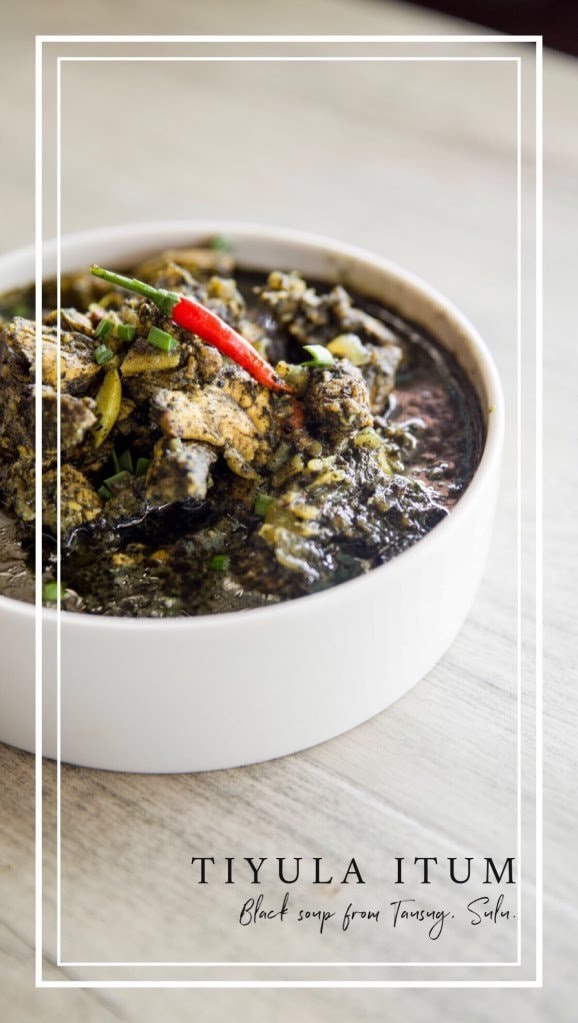
Photo source: https://www.facebook.com/zamboanga3cgroup5/photos/pcb.108390027835241/108389961168581/
3. It originated from the Tausug1 people of Mindanao2. It is also prepared in the state of Sabah, Malaysia.
4. Tiyula itum is Tausug3 for “black soup”.
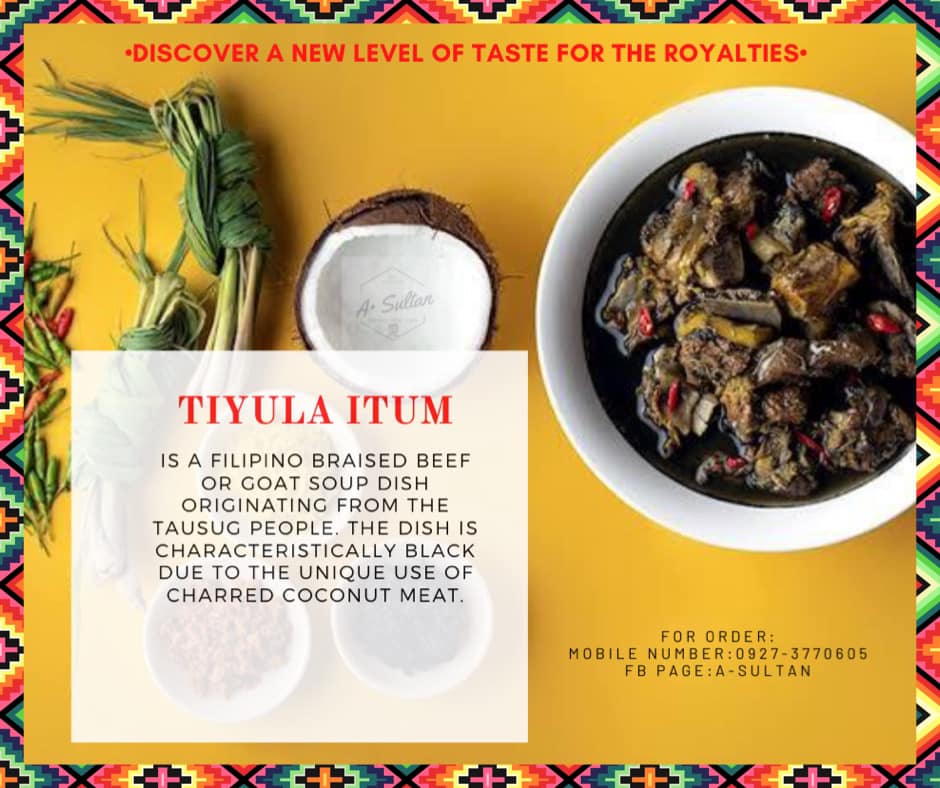
Tiyula Itum by A-Sultan – Photo source: https://www.facebook.com/ASultanAuthentic2020/photos/pcb.138833907913846/138833887913848
This dish is characteristically black because of the use of charred coconut meat which is made by charcoal or oven grilling.
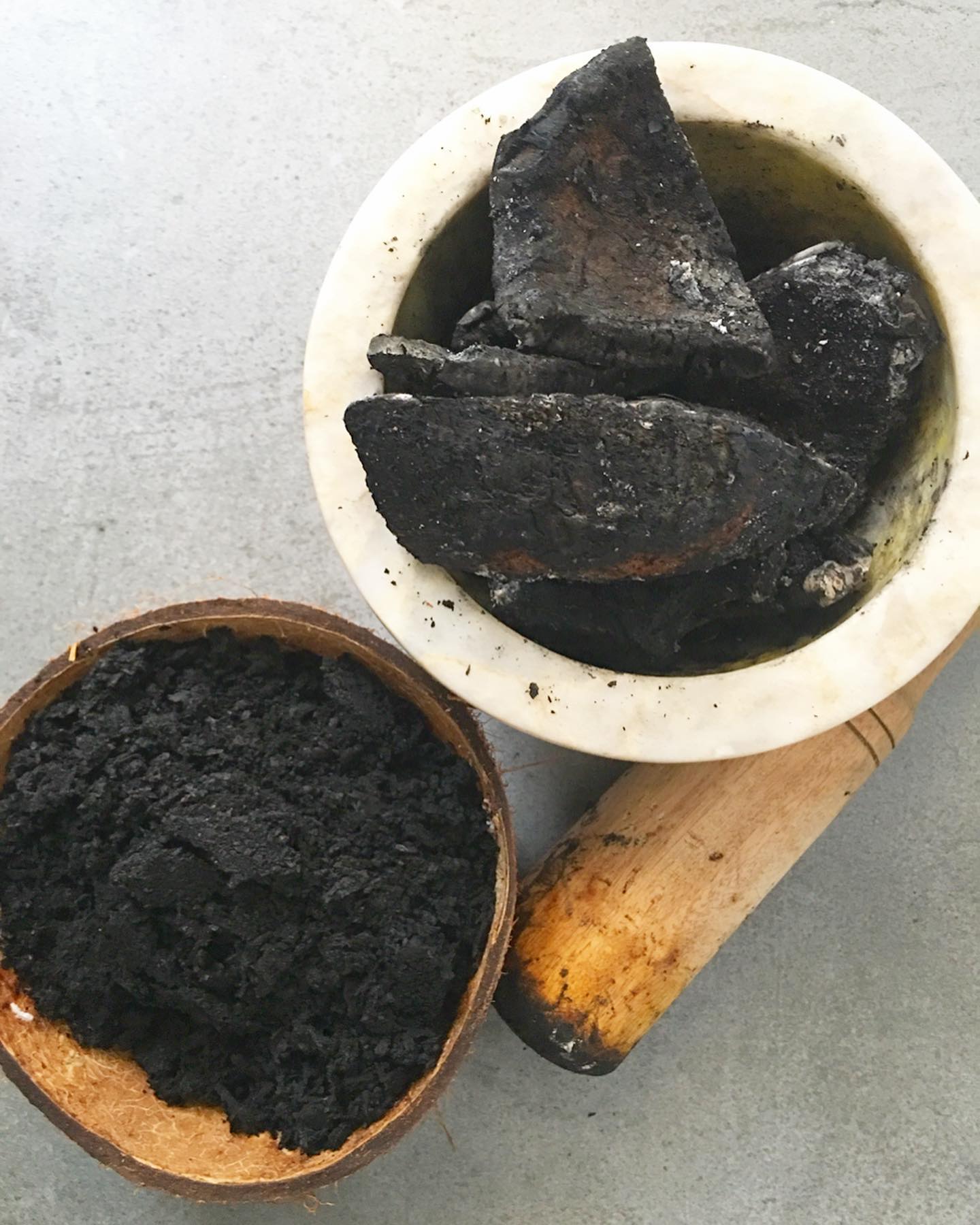
charred coconut meat – Photo source: https://www.facebook.com/The-Coconut-Dude-1938401566208710/photos/pcb.3047161128666076/3047161038666085/
It is cooled and is traditionally pounded to be in powder form but nowadays, you could use a food processor or blender. This ingredient, along with herbs and spices (see fact 6), give Tiyula Itum its full flavor and black color, which could vary as gray or dark green.
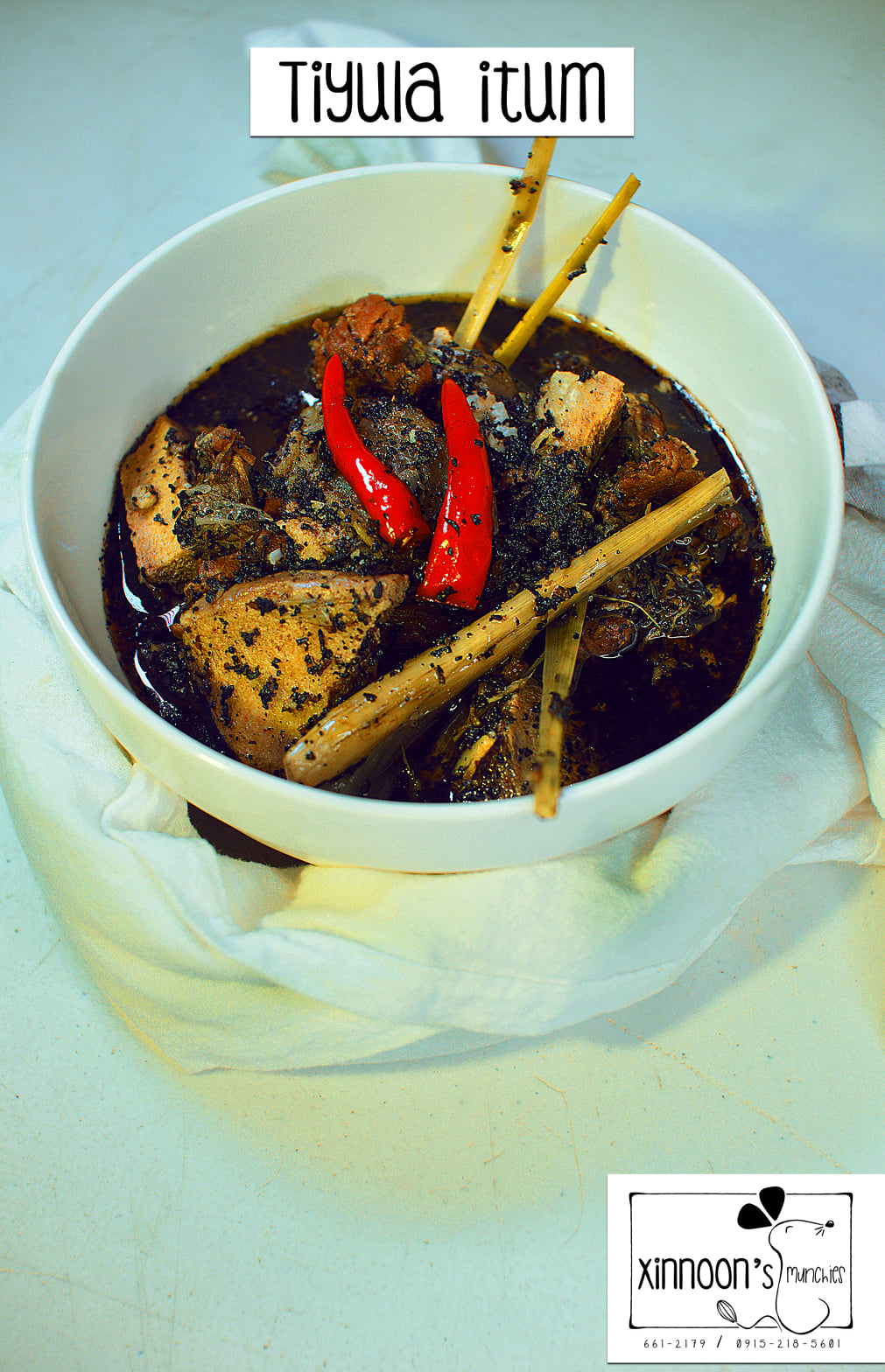
Photo source: https://www.facebook.com/XINNOONs-Munchies-111086213935498/photos/pcb.179949303715855/179949227049196/
5. It is related to two Filipino dishes – nilaga4 and tinola5.
6. How is this dish prepared?
It is prepared by rubbing and marinating chunks of beef in a pounded mixture of spices (pamapa6) and powdered burnt coconut meat.
It is then fried with garlic, onions, turmeric, ginger and galangal7. Once the meat is lightly browned, water or broth is added, along with additional ingredients like black pepper, lemongrass and shallots, and allowed to simmer until cooked.
Coconut milk is sometimes added to thicken the broth. Other ingredients like tomatoes and siling haba8 are also sometimes added.
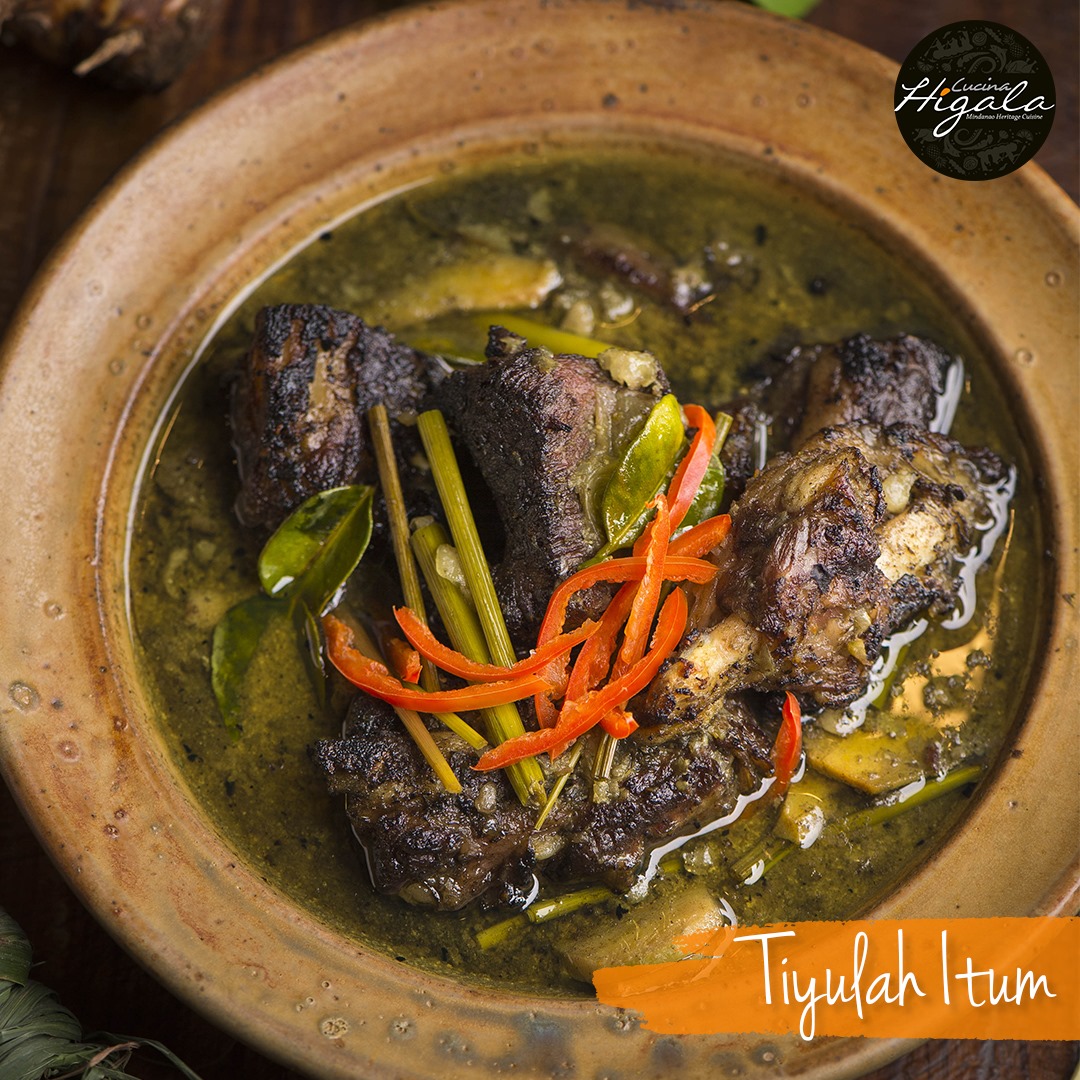
Tiyulah Itum by Cucina Higala using Bukidnon Wagyu beef, Cagayan de Oro City – Photo source: https://www.facebook.com/cucinahigala/photos/2897815057170008
7. This dish is traditionally served hot with white rice or tamu9 rice cakes.
8. Tiyula itum is culturally important among the Tausug people and is often considered “Food for the Royalty”. It is usually prepared during special occasions like weddings, and the Hari Raya10 festivals in Mindanao2.
The information was obtained from https://mb.com.ph/2021/04/15/beyond-sisig-batchoy-and-bulalo/, https://worldfood.guide/dish/tiyula_itum/, https://philippineslifestyle.com/tiyula-itum-spicy-tausug-specialty/ and the Wikipedia page “Tiyula itum”11.
The photo featured in the cover photo was obtained from https://www.facebook.com/zamboanga3cgroup5/photos/pcb.108390027835241/108389977835246/.
Tita S has not tasted this special and tasty dish but was told that it tastes way better than it looks. We got to try it then sometime soon and write about it.
This is not a sponsored post. I just want my readers to know more about Philippine delicacies.
Did you find this post informative? I would like to hear your comment/s regarding Tiyula Itum.
See other interesting posts in this category (Pinoy Delights) and other categories – SCapades and Smart Travelers – Foreign Travelers Ask, Now You Know, and Say, Say, Say. Happy reading, and I hope that you will appreciate what I shared and some of the featured destinations will be part of your future travel plans!
Remember to share this post with your Facebook friends, follow me by clicking on the bottom right corner of your device, and do not forget to like this post. Thank you.
– – – – – – – – – – – – – – – – – – – – – – – – – –
The following terms are defined for interested readers, especially those with “Senior-Moments”, those not familiar with Filipino terms, and those too busy or lazy to Google such terms:
1The Tausug, or Suluk, are an ethnic group of the Philippines and Malaysia. A small population is also found in the northern part of North Kalimantan, a province of Indonesia.
The Tausugs originally had an independent state known as the Sultanate of Sulu, which once exercised sovereignty over the present day Philippine provinces of Basilan, Palawan, Sulu, Tawi-Tawi, Zamboanga City, North Kalimantan (Indonesia), and the eastern part of Sabah (Malaysia).
They are part of the wider political identity of Muslims of Mindanao2 and the provinces of Sulu and Palawan. Most of the Tausugs have converted into the religion of Islam whose members are now more known as the Moro group, who constitute the 3rd largest ethnic group of Mindanao, Sulu and Palawan.
The information was obtained from the Wikipedia page “Tausug people”.12
2Mindanao is one of the 3 major geographical divisions of the Philippines. It is the second largest island of the country and covers 6 administrative regions13: Caraga, Davao, Northern Mindanao, SOCCSKSARGEN, Zamboanga Peninsula, and the Bangsamoro Autonomous Region in Muslim Mindanao (BARMM). It is composed of 22 provinces14 and 33 cities (27 provinces and 33 cities, if associated islands are included). The information was obtained from Wikipedia page “Mindanao.”15 Mindanao is located in the southern part of the country; the 2 other geographical divisions of the Philippines are Luzon (in the northern part) and Visayas (the middle part).
3The Tausug language is an Austronesian language spoken in the province14 of Sulu in the Philippines and in the eastern area of the state of Sabah, Malaysia, by the Tausug people1, an ethnic group in Malaysia and Mindanao2, Sulu, and southern Palawan in the Philippines. The information was obtained from the Wikipedia page “Tausug language”.16
4Nilaga is a Filipino beef or pork soup in clear broth, cooked with potatoes, cabbage or bok choy (pechay), onions, whole peppercorns and fish sauce (patis). For Beef Nilaga, the beef is brought to a boil then simmered till tender. Carrots may be added too. Ripe saba bananas can be added to Pork Nilaga.
5Tinola is a Filipino chicken soup, traditionally cooked with chicken, sautéed garlic, onions, and ginger, along with wedges of unripe papaya, and hot pepper (sili) leaves, then flavored with ground black pepper and fish sauce (patis). The information was obtained from the Wikipedia page “Tinola”.17
See my post about tinola: TEMPTING AND TASTY TINOLA
6Pamapa consists of spices combined with pounded charred mature coconut meat to flavor the beef or goat meat to prepare the dish called Tiyula Itum. It consists of chilis, garlic, ginger, lemongrass, lengkuas, onion, pepper, shallots and turmeric.18
7Galangal, or its variant galanga, is a common term for the aromatic rhizome of any of 4 plant species in the Zingiberaceae (ginger) family, namely:
* Alpinia galanga, greater galangal, laos, or lengkuas – a plant of the ginger family which bears a rhizome used largely as an herb or spice in Arabian and Southeast Asian cuisine.
* Alpinia officinarum or lesser galangal – a native to China and also grown in Japan, Thailand, Vietnam, and India. Hong Kong id the commercial center for its sale and distribution. Its rhizome is widely used nowadays in Asia where the powder form is used in curries, drinks and jellies. Its extract is used in perfumed in India and the tartars prepare a tea with it.
* Boesenbergia rotunda, Chinese ginger, Chinese keys, fingerroot, or lesser galangal – grown in China and Southeast Asia as a medicinal and culinary herb as well as as a spice, flavoring agent, dye.
* Kaempferia galanga, aromatic ginger, cutcherry, kencur, resurrection lily, or sand ginger – widely cultivate in Southeast Asia, it is used as an herb, a medicine, or in herbal drinks.
Galangals are commonly available in Asian markets as whole fresh rhizome, or in dried and sliced, or powdered form. They have medicinal effects since they promote digestion, alleviate respiratory diseases and stomach problems. Each species is attributed with specific medical virtues.
The information was obtained from the Wikipedia page “Galangal”19, “Alpinia galanga”20, “Alpinia officinarum”21, “Boesenbergia rotunda”22, and “Kaempferia galanga”23.
8Siling haba is a kind of long chili which is light green in color and belongs to the species Capsicum annuum. It is mildly spicy and is commonly used in Filipino dishes, especially in Sinigang (a sour soup), Paksiw (meat or fish in a vinegar broth), Dinuguan (Pork Blood Stew), and Kinilaw (Philippine ceviche). It is also called espada, finger chili, green chili, long pepper, and siling mahaba, siling pangsigang, siling Tagalog. The information was obtained from the Wikipedia page “Siling haba”.24
9Tamu, puso, or “hanging rice”, is a Filipino rice cake made by boiling rice in a rectangular-, diamond-, or octahedral-shaped woven pouch made of palm leaves. It is usually associated with the street food cultures of the Visayan and Moro peoples. Rice could be plain, savory or sweet.
It is traditionally prepared as a way to pack rice for journeys and is eaten held in the hands while standing, usually paired with meat or seafood cooked on skewers (inihaw or satti). It is still eaten this way from street food peddlers (pungko-pungko). In seated dining, it is commonly cut into pieces and served on a plate in place of regular rice.
The information was obtained from the Wikipedia page “Puso”.25
10Hari Raya, Buka, Hariraya Buka, or Hariraya Buka Puasa, is a common name for Eid al-Fitr, the end of the month-long fast during Ramadan25 among Filipino-Muslims, along with Muslims worldwide. It means “feast of breaking the fast”. It originated from the Islamic Prophet Muhammad as thanksgiving to Allah. This festival is characterized by the giving of gifts (known as Eidl), food sharing (salu-salo), and visiting the elderly and the sick. Fitrana or Zakat al-Fitr is practiced a day before Eid al-Fitr which involves the donation of food, alms, and basic necessities to the poor. Traditional sweet delicacies of the different Muslim Filipino ethnic groups are served for breakfast, e.g., browas, daral, dodol, jampok, panyalam, and tinagtag.
Activities include boat races, carabao fighting, dancing and horse races in Muslim cities and towns. In Metro Manila, the celebrations are usually held at the Manila Golden Mosque and the Quirino Grandstand. The celebration lasts for 3 days.
It was proclaimed a legal holiday for Muslim Filipinos in 1977 by Presidential Decree 1083 by President Ferdinand Marcos, and declared as a public national holiday by Republic Act 9177 in 2002 by President Gloria Macapagal Arroyo. The date of celebration varies yearly because it is based on the Islamic calendar “Hijra” and is also dependent on the lunar calendar.
The information was obtained from the Wikipedia page “Eid al-Fitr”.26
11“Tiyula itum,” accessed March 18, 2021, https://en.wikipedia.org/wiki/Tiyula_itum
12“Tausug people,” accessed March 18, 2021, https://en.wikipedia.org/wiki/Tausug_people
13A region is an administrative division based on geographical, cultural and ethnological characteristics. Each region is further subdivided in provinces14, composed of cities and municipalities27 (or towns), which in turn, are divided into barangays27, formerly called barrios, according to Wikipedia page “Regions of the Philippines” 28.
See a related post: Foreign Seniors Ask: WHAT ARE THE REGIONS OF THE PHILIPPINES?
14A province is the primary administrative and political division in the Philippines. It is the second-level administrative sub-division of a region13. There are 81 provinces (called lalawigan) in the Philippines. Each province is governed by an elected legislature called the Sangguniang Panlalawigan and by an elected governor. The information was obtained from Wikipedia page “Provinces of the Philippines.”29
See a related post: Foreign Seniors Ask: WHAT ARE PROVINCES IN THE PHILIPPINES?
15“Mindanao,” accessed March 18, 2021, https://en.wikipedia.org/wiki/Mindanao
16“Tausug language,” accessed March 18, 2021, https://en.wikipedia.org/wiki/Tausug_language
17”Tinola,” accessed March 18, 2021, https://en.wikipedia.org/wiki/Tinola
19“Galangal,” accessed March 18, 2021, https://en.wikipedia.org/wiki/Galangal
20“Alpinia galanga,” accessed March 18, 2021, https://en.wikipedia.org/wiki/Alpinia galanga
21“Alpinia officinarum,” accessed March 18, 2021, https://en.wikipedia.org/wiki/Alpinia_officinarum
22“Boesenbergia rotunda,” accessed March 18, 2021, https://en.wikipedia.org/wiki/Boesenbergia_rotunda
23“Kaempferia galanga,” accessed March 18, 2021, https://en.wikipedia.org/wiki/Kaempferia_galanga
24“Siling haba,” accessed July 18, 2018, https://en.wikipedia.org/wiki/Siling_haba
25“Puso,” accessed July 18, 2018, https://en.wikipedia.org/wiki/Puso
26“Eid Al-Fitr,” accessed July 18, 2018, https://en.wikipedia.org/wiki/Eid_Al-Fitr
27A municipality is a small, single urban administrative division, or local government unit (LGU)30, in the Philippines which has corporate status and powers of self-government or jurisdiction as granted by law. It is a unit under a province14, subdivided into barangays31, and is called town, or bayan. In the Philippines, a municipality is headed by a mayor, a vice mayor and members of the Sangguniang Bayan (legislative branch). The information was obtained from Wikipedia page “Municipalities of the Philippines.”32
28“Regions of the Philippines,” accessed July 18, 2018, https://en.wikipedia.org/wiki/Regions_of_the_Philippines
29“Provinces of the Philippines,” accessed July 18, 2018, https://en.wikipedia.org/wiki/Provinces_of_the_Philippines
30A local government unit (LGU) in the Philippines is divided into 3 levels: provinces14 and independent cities33; component cities34 and municipalities27; and, barangays31, according to Wikipedia page “Local government in the Philippines”.35
31A barangay is the smallest administrative division in the Philippines. It is headed by a barangay captain, aided by a Sangguniang Barangay (Barangay Council). It is the native Filipino term for a village. It was formerly called a barrio. In a metropolitan area, a barangay is an inner-city neighborhood, a suburb, or a suburban neighborhood. The word barangay originated from the term “balangay”, a kind of boat used by a group of Austronesian people who migrated to the Philippines. A number of barangays grouped together is called a district. The information was obtained from Wikipedia page “Barangay.”36
32“Municipalities of the Philippines,” accessed July 18, 2018, https://en.wikipedia.org/wiki/Municipalities_of_the_Philippines
33An independent city in the Philippines is no longer subject to review by any province’s Provincial Board (Sangguniang Panlalawigan), stops sharing its tax revejue with any province14, and is directly supervised by the President of the Philippines. There are currently 38 independent cities in the Philippines.
There are 2 kinds of independent cities:
* Highly urbanized city (HUC) – This is a city with a minimum population of 200,000 inhabitants, as certified by the Philippine Statistics Authority, and with the latest annual income of at least PHP50 million or US$1 million, as certified by the City Treasurer. There are currently 33 such cities in the Philippines.
* Independent component city (ICC) – This is a city has a charter that explicitly prohibits its residents from voting for provincial officials. There are currently 5 such cities: Cotabato, Dagupan, Naga (Camarines Sur), Ormoc and Santiago.
The information was obtained from Wikipedia page “Cities of the Philippines”.37
See a related post: Foreign Seniors Ask: HOW MANY CITIES ARE THERE IN THE PHILIPPINES?
34A component city is a type of city in the Philippines which does not meet the requirements of a highly urbanized city38 and is under the jurisdiction of a province14. If such a city is located along the boundaries of 2 or more provinces, it shall be considered part of the province of which it used to be a municipality27. The information was obtained from the Wikipedia page “Cities of the Philippines.”37
See a related post: Foreign Seniors Ask: HOW MANY CITIES ARE THERE IN THE PHILIPPINES?
35“Local government in the Philippines,” accessed April 2, 2018, https://en.wikipedia.org/wiki/Local_government_in_the_Philippines
36“Barangay,” accessed July 9, 2018, https://en.wikipedia.org/wiki/Barangay
37“Cities of the Philippines,” accessed April 2, 2018, https://en.wikipedia.org/wiki/Cities_of_the_Philippines
38Highly urbanized city – See footnote 33.

